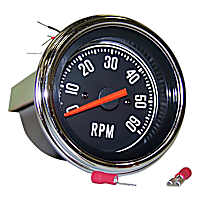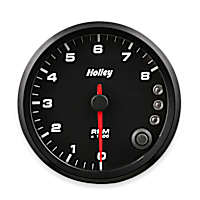Several parts in your vehicle help you keep track of its performance and condition一from its engine’s temperature to vehicle speed. These are things that are typically seen in gauges or led displays, and they usually indicate any problems your vehicle could be exhibiting.
You’ll also see your engine’s speed displayed on one of the gauges on the dashboard, which is measured in revolutions per minute (RPM).
What Does RPM Mean in a Car?
RPM stands for “revolutions per minute,” which is used to measure how fast your engine is running. More specifically, RPM is the measurement of how many rotations a crankshaft makes and how many times the pistons go up and down in their cylinders every minute.
In most cases, you’ll see the RPM displayed on the tachometer, which is located next to the speedometer. Information about engine speed is usually supplied from the powertrain control module (PCM).
Monitoring the RPM in Your Car
The tachometer is responsible for displaying your engine’s RPM. It displays single-digit markings like 1, 2, 3, etc., which are multiplied by 1000 to calculate the actual RPM. For example, if the needle is pointing to 4, it means that the engine is running at 4,000 RPM.

Manual and automatic transmission vehicles usually have a tachometer built into the dashboard, but for the latter, the tachometer is less critical.
An automatic vehicle doesn’t require the driver to shift gears manually because this process is already computerized. In most cases, the role of a tachometer on an automatic transmission vehicle is to let drivers know if the engine is running.
For manual transmission vehicles, a tachometer lets the driver know when to shift gears. The far end of the gauge has a red line that indicates when the vehicle is reaching the maximum RPM for a specific gear. By monitoring the tachometer, drivers can stay away from the red zone to prevent engine damage.
For more information about the tachometer, you can read our comprehensive guide about it here.
What RPM Should Your Car Idle At?
An idling speed that’s anywhere between 600 and 1000 RPMs is a good indicator that your vehicle is running as it should. There are, however, some instances where the right idling speed is determined by the type of engine your vehicle has.
For example, a 2.0-liter engine might have an idle speed between 500 and 800 RPM, while a 2.5-liter engine might have an idle speed ranging from 550 to 750 RPM.
Why Is My Car’s RPM Jumping?
Many different issues can cause your tachometer readings to jump. And while this might seem like a simple wiring issue on the surface, it could also mean that a bigger problem could be brewing under the hood.

Often, a tachometer that’s jumping up and down while the vehicle is stopped indicates an uneven idle condition. The root cause of the issue could be anything from a vacuum leak to an internal engine concern.
Shopping for a Replacement Tachometer
Aside from displaying your vehicle’s engine speed, the tachometer also plays an important role in alerting the driver of issues the vehicle could be exhibiting. So it’s important to replace it as soon as it gets damaged.
Here are some factors you should consider when you’re in the market for a replacement tachometer.
Vehicle Specifications
Finding the right tachometer replacement largely depends on your vehicle’s year, make, and model. Keeping these details in mind while you shop will help you find a direct-fit replacement for your old tachometer.
Tachometer Type
Your vehicle can come with a mechanical, analog, or digital tachometer. For more information about how each type differs from one another, check out this article.
OEM vs. Aftermarket Tachometer
Both original equipment (OE) and aftermarket tachometers are built using the same heavy-duty materials and undergo similar testing procedures to ensure long-lasting durability and dependability. But if you’re looking for a more cost-effective route, you can opt to get an aftermarket tachometer instead.

Aftermarket tachometers work the same way as OE variants. But because they don’t carry the automaker’s brand name, they tend to cost less than their OE counterparts.
Featured RPM Gauges
With the many tachometer brands in the market, it can be hard to choose one that best fits your vehicle. Check out our top picks below.
Autometer 2304 Tachometer – Electric Air-Core, Universal, Sold Individually
Key Features:
- Easy to install
- Comes with a choice of RPM redlines ranging from 4,000 to 11,000 RPM
- Available in full-dial, high-definition, back-lit, and perimeter incandescent lighting types
Crown J5459418 Tachometer, Direct Fit – Sold Individually
Key Features:
- Comes as a direct-fit replacement for various Jeep models
- Comes with a one-year or 12,000-mile limited Crown warranty
- Passed ISO/TS 16949 quality standards
Holley 26-615 Tachometer – Sold Individually
- Has a slim mounting style to optimize dashboard space
- Features a LED dimmable back-lit design
- Comes with programmable internal LED shift lights
Any information provided on this Website is for informational purposes only and is not intended to replace consultation with a professional mechanic. The accuracy and timeliness of the information may change from the time of publication.


 Autometer 2304 Tachometer
Autometer 2304 Tachometer
 Crown J5459418 Tachometer
Crown J5459418 Tachometer
 Holley 26-615 Tachometer
Holley 26-615 Tachometer
















